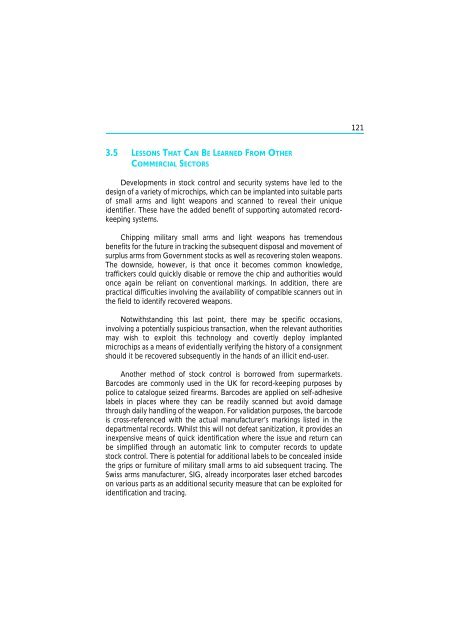The Scope and Implications of a Tracing Mechanism for Small Arms ...
The Scope and Implications of a Tracing Mechanism for Small Arms ...
The Scope and Implications of a Tracing Mechanism for Small Arms ...
You also want an ePaper? Increase the reach of your titles
YUMPU automatically turns print PDFs into web optimized ePapers that Google loves.
121<br />
3.5 LESSONS THAT CAN BE LEARNED FROM OTHER<br />
COMMERCIAL SECTORS<br />
Developments in stock control <strong>and</strong> security systems have led to the<br />
design <strong>of</strong> a variety <strong>of</strong> microchips, which can be implanted into suitable parts<br />
<strong>of</strong> small arms <strong>and</strong> light weapons <strong>and</strong> scanned to reveal their unique<br />
identifier. <strong>The</strong>se have the added benefit <strong>of</strong> supporting automated recordkeeping<br />
systems.<br />
Chipping military small arms <strong>and</strong> light weapons has tremendous<br />
benefits <strong>for</strong> the future in tracking the subsequent disposal <strong>and</strong> movement <strong>of</strong><br />
surplus arms from Government stocks as well as recovering stolen weapons.<br />
<strong>The</strong> downside, however, is that once it becomes common knowledge,<br />
traffickers could quickly disable or remove the chip <strong>and</strong> authorities would<br />
once again be reliant on conventional markings. In addition, there are<br />
practical difficulties involving the availability <strong>of</strong> compatible scanners out in<br />
the field to identify recovered weapons.<br />
Notwithst<strong>and</strong>ing this last point, there may be specific occasions,<br />
involving a potentially suspicious transaction, when the relevant authorities<br />
may wish to exploit this technology <strong>and</strong> covertly deploy implanted<br />
microchips as a means <strong>of</strong> evidentially verifying the history <strong>of</strong> a consignment<br />
should it be recovered subsequently in the h<strong>and</strong>s <strong>of</strong> an illicit end-user.<br />
Another method <strong>of</strong> stock control is borrowed from supermarkets.<br />
Barcodes are commonly used in the UK <strong>for</strong> record-keeping purposes by<br />
police to catalogue seized firearms. Barcodes are applied on self-adhesive<br />
labels in places where they can be readily scanned but avoid damage<br />
through daily h<strong>and</strong>ling <strong>of</strong> the weapon. For validation purposes, the barcode<br />
is cross-referenced with the actual manufacturer’s markings listed in the<br />
departmental records. Whilst this will not defeat sanitization, it provides an<br />
inexpensive means <strong>of</strong> quick identification where the issue <strong>and</strong> return can<br />
be simplified through an automatic link to computer records to update<br />
stock control. <strong>The</strong>re is potential <strong>for</strong> additional labels to be concealed inside<br />
the grips or furniture <strong>of</strong> military small arms to aid subsequent tracing. <strong>The</strong><br />
Swiss arms manufacturer, SIG, already incorporates laser etched barcodes<br />
on various parts as an additional security measure that can be exploited <strong>for</strong><br />
identification <strong>and</strong> tracing.
















